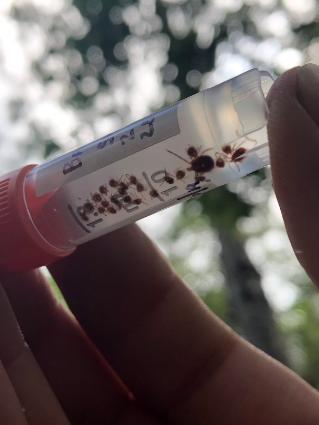Can invasive plants increase tick exposure risk? Scientists reveal a surprising link to human health
An invasive grass found on almost every continent and considered a pest in 73 countries isn’t just weeding out native plants, it is creating a haven for disease-carrying ticks and raising public health risk concerns.
A new University of Florida study, published recently in Ecology, demonstrates how cogongrass, an invasive grass common across the Southeast United States is enhancing tick survival. Researchers at UF’s Invasion Science Institute (ISI) found that lone star ticks, a species common in the Southeast and known to bite humans, survive more than 50% longer in areas dominated by invasive cogongrass than in native plant communities.
“The direct effects of invasive plants are well known, but these finds show that invasions can also indirectly impact human health by prolonging tick survival” said Luke Flory, professor and associate chair of the agronomy department at UF’s Institute of Food and Agricultural Sciences (UF/IFAS) and director of the UF Invasion Science Institute (ISI).
Longer tick survival means more opportunities to feed on hosts like deer, and more opportunities to spread disease to people and wildlife.

“In this study we used one of the most widely distributed and problematic invasive grass species in the Southeast, as well as the most common tick species of the region,” said Drew Hiatt, lead author of the study and a graduate student at UF/IFAS. “Our results suggest that Floridians would be at an increased risk of tick-borne disease while recreating in invaded plant communities.”
The research team compared invaded and native plant areas and found similar levels of deer activity, meaning the number of hosts wasn’t what drove the difference. Instead, the densely growing invasive grass altered the local environment, making it cooler and more humid, which provided conditions that help ticks avoid drying out and dying.
“Adult ticks survived over 100 days longer in invaded plant communities compared to native plant-dominated areas, due to changes in the microclimate caused by the invasion,” said Hiatt. “We also found similar host activity of white-tailed deer in both plant communities, suggesting that longer survival of ticks is the dominant driver of tick abundance in invaded areas.”
Cogongrass, native to Southeast Asia, was introduced to the U.S. nearly a century ago and has since spread across millions of acres in the Southeast. Known for its ability to form dense stands that outcompete native vegetation and increase wildfire risk, cogongrass now appears to have public health implications as well according to the research outcomes.
“Invasive plants are often managed for their ecological and economic impacts,” said Hiatt. “This research highlights that they should also be managed to minimize their impact on public health.”
Researchers added this study is just one example of how invasive plants can quietly change ecosystems in ways that affect humans.
“Previous studies have found a similar link between the aquatic invasive plant water lettuce and malaria outbreaks via mosquitoes,” said Hiatt.
He hopes the findings encourage land managers, policymakers and the public to think differently about the stakes of invasive species management.
“It would be great to see more research on the indirect effects of plant invasions and vector-borne disease risk,” Hiatt said. “An increased allocation of resources for invasive plant removal could help reduce tick-borne disease risk in invaded areas.”
